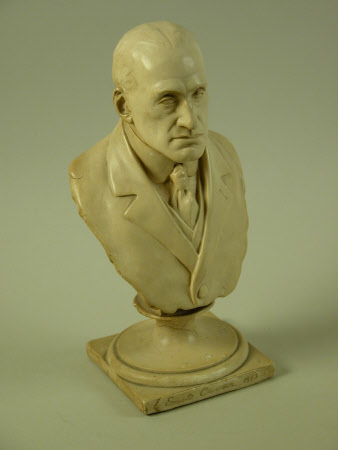Portrait of Sir Edward Henry Carson, Baron Carson (1854-1935)
Fergus Scott Hurd-Wood (1872-1936)
Category
Art / Sculpture
Date
1913
Materials
Plaster
Measurements
299 x 154 x 121 mm
Place of origin
London
Order this imageCollection
Mount Stewart, County Down
NT 1221038
Summary
Sculpture, patinated plaster; Rt. Hon. Sir Edward Henry Carson, K.C., later Baron Carson (1854-1935); Fergus Hurd-Wood (1872-1936). A portrait of Edward Carson, lawyer and politician, who led unionist resistance in Ulster to the British government’s plan to introduce Home Rule for Ireland.
Full description
A bust portrait of the lawyer and politician Sir Edward Carson, later Baron Carson (1854-1935), made in 1913 by Fergus Scott Hurd-Wood (1872-1936). Carson is depicted facing to his front and with a serious expression. He is formally dressed,with his coat tightly buttoned. On an integral curving support, in turn on a circular socle, culminating in a rectangular base, bearing the name of the sitter. The artist’s signature and a lengthy inscription recording the producer of the bust, the Art Reproduction Company, are on the back. A label on the underside of the base, ‘418’. Edward Carson was one of the founders of modern Ulster unionism. Born and brought up in Southern Ireland, he began his legal career practising at the Irish bar, becoming Irish solicitor general. In 1892 he was elected to the House of Commons and in 1893 was called to the English bar, serving as British solicitor general between 1900 and 1905. In 1910 Carson agreed to devote his energies to Ulster and became leader of the Irish Unionist party, which opposed Home Rule for the island of Ireland. Carson and his party fiercely resisted the attempt by Herbert Asquith in 1912 to promote a Bill for Home Rule for Ireland, helping to organise mass protests in Ulster. In September 1913, Carson declared himself ready to form a provisional government in Ulster and in the same year formed the Ulster Volunteer Force, a private paramilitary force that readied itself to fight, in the event of the imposition of Home Rule on Ulster. Eventually the British government, faced with the new challange of the outbreak of World War I, agreed that although the Home Rule Bill passed, its implementation would be delayed until the end of hostilities, and Ulster’s position could be reconsidered at that stage. Carson, who served in Government throughout the War, was disillusioned with the Government of Ireland Act of 1920, which resulted in the partitioning of Ireland and the establishment of a separate parliament in Belfast, and subsequently retired from politics. By 1913, when the portrait sculpture at Mount Stewart was made, Carson had long been on friendly terms with the Londonderrys. 1913 was the year when resistance to Home Rule was at its fiercest among Ulster unionists. When 500 delegates of the Ulster Unionist Council met in Belfast to approve the establishment of an Ulster Provisional Government, Carson beseeched Lord Londonderry not to ally himself with the movement, writing that ‘They can do little to me, therefore I have little to fear. But you have great possessions, a great title, friendships at Court, a seat in the House of Lords. You have to consider the future of your son Charley. The Government, when they grow vindictive, as they will, may strike at you – and him. For these good reasons keep out of it! Let me do it by myself. It matters little to me, but I do not want you to be involved in this last and ultimate matter!’ (H. Montgomery Hyde, The Londonderrys. A Family Portrait, London 1979, p. 112). Nevertheless, Lord Londonderry assured Carson that ‘if I was to lose everything in the world, I will go though with you to the end!’ and accepted the chairmanship of the Unionist Council. The portrait bust was perhaps commissioned by Lord Londonderry at this time. It appears to exist in just this single version, although the prominent inscription for the Art Reproduction Company would imply it was made as an edition for sale. The Art Reproduction Company was a London-based printing company active in the decades around 1900, that specialised in fine printing, including photogravure. The sculptor of the portrait, Fergus Scott Hurd-Wood, practised both as a painter and a sculptor, exhibiting occasionally at the Royal Academy and at the exhibitions of the International Society of Painters, Sculptors and Gravers. In 1913, Hurd-Wood exhibited what is possibly the present sculpture at the Autumn exhibition of the Society, held at the Grafton Galleries, a sculpture in plaster entitled ‘The White Arm’ (no. 20). If the title is symbolic, it might refer to how men showing their promise of allegiance to the Ulster Volunteer Force were recorded as arriving at Belfast City Hall wearing bowler hats and white armlets, and carrying white staves. Hurd-Wood fought in both the Boer and the First World Wars, losing the use of his right forefinger in the latter conflict, which greatly limited his ability to work as a sculptor thereafter. Jeremy Warren May 2022
Provenance
Probably acquired by Charles Vane-Tempest-Stewart, 6th Marquess of Londonderry (1852-1915); given to the National Trust from Lady Mairi Bury (1921-2009) in 1976.
Marks and inscriptions
Back of support, incised: PUBLISHED/ By/ The Art/ Reproduction Co./ 9 Howland St./ London/ Copyright 1913 Back of bust, incised: F. Hurd-Wood/ Sc. Front of base, in cartouche, incised: Edward Carson 1913
Makers and roles
Fergus Scott Hurd-Wood (1872-1936), sculptor
References
International Society of Sculptors, Painters and Gravers. Catalogue of the Autumn Exhibition 1913, Grosvenor Gallery, London 1913, p. 17, no. 20.
